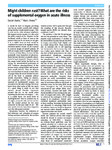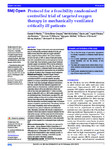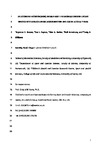Might children rust? What are the risks of supplemental oxygen in acute illness
| dc.contributor.author | Martin, D | |
| dc.contributor.author | Peters, MJ | |
| dc.date.accessioned | 2020-07-09T13:22:58Z | |
| dc.date.issued | 2018-09-03 | |
| dc.identifier.issn | 0003-9888 | |
| dc.identifier.issn | 1468-2044 | |
| dc.identifier.uri | http://hdl.handle.net/10026.1/15938 | |
| dc.description | No embargo required. | |
| dc.description.abstract |
It would be hard to imagine providing care for an acutely unwell child without giving him/her supplemental oxygen. This is what we do, what advanced paediatric life support courses require; it is also what the public expects of us. Oxygen—in the developed world at least—is seen as the panacea that can do no harm, to not give it in a child’s hour of need would be considered by some to be negligent. Every television medical drama we are exposed to contains images of unwell patients, all with an oxygen mask to signify the degree of severity of their illness. So how did this potentially toxic byproduct of photosynthesis become the most commonly administered drug in hospitals? Oxygen unlocks the energy stored within the food we eat during the mitochondrial production of ATP: ‘oxidative phosphorylation’. If this process ceases, energy failure and hypoxic death usually follows. Thus, for decades our focus has been to ensure a steady flow of oxygen from the air we breathe to every cell in the body to maintain cellular aerobic respiration. Taking no chances, and supplying patients with excessive amounts of supplemental oxygen, was assumed to be the safest strategy. But as we know from other walks of life, too much of a good thing is rarely in our best interest. Joseph Priestley eloquently pointed this out to the world when reporting his discovery of oxygen: ‘…for, as a candle burns out much faster in dephlogisticated than in common air, so we might, as may be said, live out too fast and the animal powers be too soon exhausted in this pure kind of air’. His wise words seem to have been forgotten over the subsequent centuries. | |
| dc.format.extent | 106-107 | |
| dc.format.medium | Print-Electronic | |
| dc.language | en | |
| dc.language.iso | en | |
| dc.publisher | BMJ | |
| dc.subject | hypoxia | |
| dc.subject | oxidative stress | |
| dc.subject | oxygen | |
| dc.subject | reactive oxygen species | |
| dc.subject | Acute Disease | |
| dc.subject | Child | |
| dc.subject | Humans | |
| dc.subject | Hypoxia | |
| dc.subject | Oxygen | |
| dc.subject | Oxygen Inhalation Therapy | |
| dc.title | Might children rust? What are the risks of supplemental oxygen in acute illness | |
| dc.type | journal-article | |
| dc.type | Editorial Material | |
| plymouth.author-url | https://www.ncbi.nlm.nih.gov/pubmed/30213801 | |
| plymouth.issue | 2 | |
| plymouth.volume | 104 | |
| plymouth.publication-status | Published | |
| plymouth.journal | Archives of Disease in Childhood | |
| dc.identifier.doi | 10.1136/archdischild-2018-315437 | |
| plymouth.organisational-group | /Plymouth | |
| plymouth.organisational-group | /Plymouth/Faculty of Health | |
| plymouth.organisational-group | /Plymouth/REF 2021 Researchers by UoA | |
| plymouth.organisational-group | /Plymouth/REF 2021 Researchers by UoA/UoA01 Clinical Medicine | |
| plymouth.organisational-group | /Plymouth/Users by role | |
| plymouth.organisational-group | /Plymouth/Users by role/Academics | |
| dc.publisher.place | England | |
| dcterms.dateAccepted | 2018-08-07 | |
| dc.rights.embargodate | 2020-7-13 | |
| dc.identifier.eissn | 1468-2044 | |
| dc.rights.embargoperiod | Not known | |
| rioxxterms.versionofrecord | 10.1136/archdischild-2018-315437 | |
| rioxxterms.licenseref.uri | http://www.rioxx.net/licenses/all-rights-reserved | |
| rioxxterms.licenseref.startdate | 2018-09-03 | |
| rioxxterms.type | Journal Article/Review |





